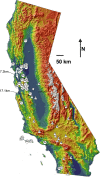Two cryptic species of California mustard within Caulanthus lasiophyllus
- PMID: 33370466
- PMCID: PMC7839454
- DOI: 10.1002/ajb2.1562
Two cryptic species of California mustard within Caulanthus lasiophyllus
Abstract
Premise: Cryptic species are evolutionarily distinct lineages lacking distinguishing morphological traits. Hidden diversity may be lurking in widespread species whose distributions cross phylogeographic barriers. This study investigates molecular and morphological variation in the widely distributed Caulanthus lasiophyllus (Brassicaceae) in comparison to its closest relatives.
Methods: Fifty-two individuals of C. lasiophyllus from across the species' range were sequenced for the nuclear ribosomal internal transcribed spacer region (ITS) and the chloroplast trnL-F region. A subset of these samples were examined for the chloroplast ndhF gene. All 52 individuals were scored for 13 morphological traits, as well as monthly and annual climate conditions at the collection locality. Morphological and molecular results are compared with the closest relatives-C. anceps and C. flavescens-in the "Guillenia Clade." To test for polyploidy, genome size estimates were made for four populations.
Results: Caulanthus lasiophyllus consists of two distinct lineages separated by eight ITS differences-eight times more variation than what distinguishes C. anceps and C. flavescens. Fewer variable sites were detected in trnL-F and ndhF regions, yet these data are consistent with the ITS results. The two lineages of C. lasiophyllus are geographically and climatically distinct; yet morphologically overlapping. Their genome sizes are not consistently different.
Conclusions: Two cryptic species within C. lasiophyllus are distinguished at the molecular, geographic, and climatic scales. They have similar genome sizes and are morphologically broadly overlapping, but an ephemeral basal leaf character may help distinguish the species.
Keywords: Brassicaceae; California mustard; annual precipitation; chloroplast ndhF gene; chloroplast trnL-F region; internal transcribed spacer region; mean temperature; morphological analysis.
© 2020 The Authors. American Journal of Botany published by Wiley Periodicals LLC on behalf of Botanical Society of America.
Figures






Similar articles
-
Evolution of the chloroplast trnL-trnF region in the gymnosperm lineages Taxaceae and Cephalotaxaceae.Biochem Genet. 2009 Jun;47(5-6):351-69. doi: 10.1007/s10528-009-9233-7. Epub 2009 Feb 28. Biochem Genet. 2009. PMID: 19252978
-
Evolution of Caulanthus amplexicaulis var. barbarae (Brassicaceae), a rare serpentine endemic plant: a molecular phylogenetic perspective.Am J Bot. 2001 Aug;88(8):1479-89. Am J Bot. 2001. PMID: 21669681
-
Molecular phylogenetic study of Cardamine amaraeformis Nakai using nuclear and chloroplast DNA markers.Genet Mol Res. 2012 Aug 31;11(3):3086-90. doi: 10.4238/2012.August.31.6. Genet Mol Res. 2012. PMID: 23007986
-
Molecular phylogenetics supports widespread cryptic species in moonworts (Botrychium s.s., Ophioglossaceae).Am J Bot. 2014 Jan;101(1):128-40. doi: 10.3732/ajb.1300154. Epub 2014 Jan 7. Am J Bot. 2014. PMID: 24401328
-
Chloroplast DNA phylogeography of Clintoniaudensis Trautv. & Mey. (Liliaceae) in East Asia.Mol Phylogenet Evol. 2010 May;55(2):721-32. doi: 10.1016/j.ympev.2010.02.010. Epub 2010 Feb 19. Mol Phylogenet Evol. 2010. PMID: 20172032 Review.
References
-
- Al‐Shehbaz. I. A. 2010. Caulanthus In: Flora of North America Editorial Committee , (eds.), Flora of North America North of Mexico, vol. 7, Magnoliophyta: Salicaceae to Brassicaceae, New York and Oxford, USA.
-
- Al‐Shehbaz, I. A. 2012. A generic and tribal synopsis of the Brassicaceae (Cruciferae). Taxon 61: 931–954.
-
- Al‐Shehbaz, I. A. , Beilstein M. A., and Kellogg E. A.. 2006. Systematics and phylogeny of the Brassicaceae (Cruciferae): an overview. Plant Systematics and Evolution 259: 89–120.
-
- Anacker, B. L. , Whittall J. B., Goldberg E. E., and Harrison S. P.. 2011. Origins and consequences of serpentine endemism in the California flora. Evolution 65: 365–376. - PubMed
-
- Angert, A. L. , and Schemske D. W.. 2005. The evolution of species’ distributions: reciprocal transplants across the elevation ranges of Mimulus cardinalis and M. lewisii . Evolution 59: 1671–1684. - PubMed
Publication types
MeSH terms
Substances
LinkOut - more resources
Full Text Sources

